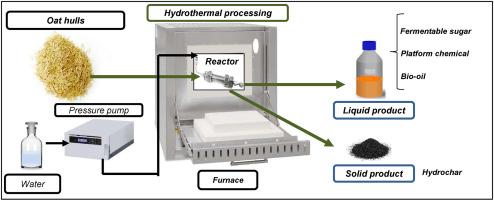半连续水热法将燕麦壳转化为燃料和前体
IF 5.8
2区 生物学
Q1 AGRICULTURAL ENGINEERING
引用次数: 0
摘要
水热法以水为溶剂,在高热力学条件下转化木质纤维素生物质,是一种环保且有前景的替代方法。亚临界水条件被用于水解碳水化合物,包括存在于燕麦壳中的纤维素和半纤维素,以生产生物燃料和作为平台化学品和可发酵糖的前体。在评估温度(300°C和330°C)和20 MPa下,木质纤维素生物质的协同转化使该工艺适用于生产不同的产品。在这种极端的温度和压力条件下,由于温度控制困难和工艺线堵塞,以半连续模式运行是一个挑战。在300°C时,溶剂-料比(S/F 3.7和S/F 60)均获得最高的可发酵糖(4.98 g/100 g燕麦壳)和平台化学物质(5.48 g/100 g燕麦壳)产量。在相同的溶剂/饲料条件下,在330℃的温度下,生物油的产率最高(43.11 g/100 g)。本文章由计算机程序翻译,如有差异,请以英文原文为准。

Semi-continuous hydrothermal process for conversion oat husks to fuel and precursors
The hydrothermal process uses water as a solvent and high thermodynamic condition for converting lignocellulosic biomass, being an environmentally friendly and promising alternative. Subcritical water conditions were exploited for hydrolysis carbohydrates, including cellulose and hemicellulose, present in oat hulls, in order to produce biofuels and precursors as platform chemicals and fermentable sugars. A synergistic conversion of lignocellulosic biomass at the evaluated temperatures (300 and 330 °C) and 20 MPa, makes the process versatile for producing different products. Under these drastic temperature and pressure conditions, it was a challenge to operate in semi-continuous mode due to difficult temperature control and blockages in the process lines. At 300 °C, the highest yields of fermentable sugars (4.98 g/100 g oat hulls) and platform chemicals (5.48 g/100 g oat hulls) were obtained for both solvent-to-feed ratios (S/F 3.7 and S/F 60). The greatest bio-oil yield (43.11 g/100 g oat hulls) was achieved at 330 °C under the same solvent/feed conditions.
求助全文
通过发布文献求助,成功后即可免费获取论文全文。
去求助
来源期刊

Biomass & Bioenergy
工程技术-能源与燃料
CiteScore
11.50
自引率
3.30%
发文量
258
审稿时长
60 days
期刊介绍:
Biomass & Bioenergy is an international journal publishing original research papers and short communications, review articles and case studies on biological resources, chemical and biological processes, and biomass products for new renewable sources of energy and materials.
The scope of the journal extends to the environmental, management and economic aspects of biomass and bioenergy.
Key areas covered by the journal:
• Biomass: sources, energy crop production processes, genetic improvements, composition. Please note that research on these biomass subjects must be linked directly to bioenergy generation.
• Biological Residues: residues/rests from agricultural production, forestry and plantations (palm, sugar etc), processing industries, and municipal sources (MSW). Papers on the use of biomass residues through innovative processes/technological novelty and/or consideration of feedstock/system sustainability (or unsustainability) are welcomed. However waste treatment processes and pollution control or mitigation which are only tangentially related to bioenergy are not in the scope of the journal, as they are more suited to publications in the environmental arena. Papers that describe conventional waste streams (ie well described in existing literature) that do not empirically address ''new'' added value from the process are not suitable for submission to the journal.
• Bioenergy Processes: fermentations, thermochemical conversions, liquid and gaseous fuels, and petrochemical substitutes
• Bioenergy Utilization: direct combustion, gasification, electricity production, chemical processes, and by-product remediation
• Biomass and the Environment: carbon cycle, the net energy efficiency of bioenergy systems, assessment of sustainability, and biodiversity issues.
 求助内容:
求助内容: 应助结果提醒方式:
应助结果提醒方式:


